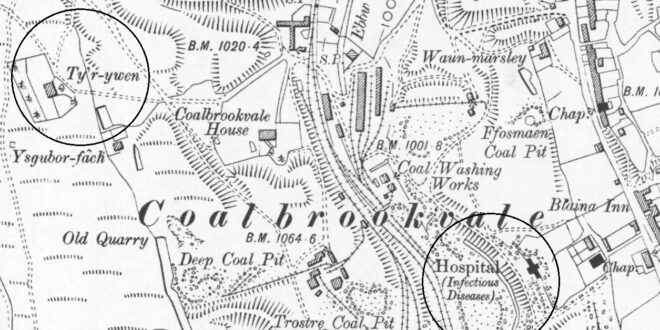Nantyglo and Blaina Hospital for Infectious Diseases.
Epidemics.
Throughout time many epidemics had broken out in England and Wales. Since records began in the 1600’s they were mainly confined to large cities and spread through the populous areas with poor sanitary conditions and inadequate supplies of drinking water. Though as the population grew and expanded (mostly in primitive conditions) to the large industrial areas the length and breadth of the country, the germs and viruses inevitably followed and the various epidemics struck the nation.
From the mid to late 1880’s a few epidemics were reported in the valley between Brynmawr and Blaina. Just a few instances of the early cases are as follows – In November 1885 it was reported in the South Wales Daily News, a meeting of the Rural Sanitary Authority of the Parish of Aberystruth was held at the Bush Hotel, Blaina, Mr Thomas Thomas (Chairman), Mr J. Collins (Inspector). It was reported that there was scarcely a street in Blaina in which measles had not broken out, the same was the case at Cwmcelyn and Garnvach. There was one case of typhoid fever at Blaina and one at Garnvach, Nantyglo.
From the late 1880’s to the early 1900’s many towns and large villages suffered from these infectious diseases and the councils planned to establish isolation hospitals also known as fever hospitals. The Nantyglo and Blaina District Local Board originally utilised the Blaina Lawn Tennis Club pavilion after the first outbreak in 1892, then as the diseases seemed likely to spread, had a purpose-built hospital built close to the Berea Chapel opposite the Blaina Inn.
The Blaina Nantyglo Border.
The official border between Blaina and Nantyglo was the Blaina Inn, anything above the Blaina Inn was Nantyglo and anything below was classed as Blaina. The first isolation hospital (as seen circled on the right on the featured map above) was well below the Blaina Inn and therefore known as the Blaina Isolation Hospital.
In 1903-1904 the Blaina Isolation Hospital became unfit for purpose and the council purchased Ty-yr-Ywen and converted that property into an isolation hospital, this house was above the Blaina Inn and (as seen circled on the featured map above far left) was at Coalbrookvale and thereafter known as the Nantyglo Isolation Hospital.
The Beginning of the Isolation Hospitals Story at Blaina and Nantyglo.
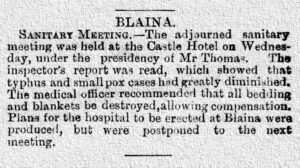 The Planned Isolation Hospital.
The Planned Isolation Hospital.
In May 1885 at a Sanitary meeting at the Castle Hotel with Mr Thomas as chairman it was announced that after the recent epidemics the cases of typhus and smallpox had greatly diminished. The medical officer stated all bedding and blankets had been destroyed to stop any further possible contamination. Plans for an isolation hospital to be erected at Blaina were produced but were postponed until a later date.
On Tuesday 8th of March 1887, a meeting of the Nantyglo and Blaina Local Board was held at the Blaina Inn, Blaina. Those present were as follows – Mr John Dakers (Acting Chairman); Mr J. P. D. Williams; Mr James Allen; Mr W. Perry (Contractor); Mr Daniel Lewis; Mr Edmund Evans; Mr George Bennett; Mr John Evans; Mr W. Parry (Grocer); Mr Lewis Davies; Mr G. R. Harris; Mr John Alexandra Shepard (Clerk); Mr Alexander Mitchell (Surveyor); Mr J. T. Thomas (Engineer) and Mr W. J. Allen (Collector): At this meeting the health of the district was debated and the various cases of infectious diseases were announced and the medical officers report was read as follows – The number of deaths for the four weeks ending February 26th 1887 were 23, 13 males and 10 females. The number of births for the same period were 25. The sewers at Shop Row were chocked up, the sewers at Church Street, Hope Street Queen Street and practically all of the eastern side of Blaina were in a very unsatisfactory condition and many houses without closets. It was stated that the period between 22nd May 1886 and the end of December 1886 there were 157 deaths registered in the district, 85 males and 72 females. The number of births over the same period were 253, 150 males and 103 females registered in the district.
The high death rate was attributed to the whooping cough epidemic which began in May 1886 and to which 21 deaths were credited, to a less extent though just as deadly was the epidemic of scarlatina to which 13 deaths were attributed. Other deaths reported and recorded at the following addresses were – Respiratory diseases 38, cancer 4, croup 1, diarrhoea 9, accidents 5 and many other causes. The addresses of the cases of the diseases were – Globe Pit Row, Hope Street, Club Row, River Row, Parsons Row, Lamb Inn, Parsons Row, Windsor Terrace, Inkerman Row, Queen Street, Cwmcelyn, Griffin Inn and the Greyhound on the Garn.
The 13 cases of scarlatina appeared at the following addresses – Stones Houses, Queen Street, near the Lamb Inn, near the Castle Hotel, Pump Street, Globe Pit Row, Church Street, Railway Terrace and Upper Road at Garnvach. There were seven cases of typhoid fever in the district, 1 at Stores Row, Nantyglo and 6 at Cokers Row, Garnfach. The drinking water at this time was being imported from a distance to stop contamination.
In 1890-1891 an influenza epidemic hit vast areas of northern Europe including Wales which resulted in many deaths, reports in newspapers said it was heading towards the United States.
In August 1891 the South Wales Gazette reported on a scarlet fever epidemic raging in Abertillery and the daughter of Rev T. Griffiths sadly dying from the disease, it was stated that Dr Williams had issued a placard to the inhabitants instructing them on how to deal with the disease which if carried out properly would go a long way on mitigating the severity of the epidemic.
Towards the end of 1891, apart from the scarlet fever and influenza, a sharp rise in cases of measles appeared at Abertillery and schools in the district closed in the hope that it would stop the spread of this epidemic. Eventually towards the end of 1891 the schools were said to be re-opened even though various epidemics were still raging in the district. In April 1892 the Waunllwydd, Cwm and Llandavell villages were hit with another measles outbreak and all the schools remain closed.
The Need for an Isolation Hospital at Blaina.
On Thursday 26th of May 1892, at a monthly meeting of the Nantyglo and Blaina Local Board with Mr John Dakers (Chairman), the Medical Officer reported a case of smallpox at 6 River Row, Blaina, it was attended to by Dr Browne. The case was treated so seriously that the sanitary committee obtained permission to use the Blaina Lawn Tennis Club pavilion for the reception of the female patient and a nurse to be engaged for her care. The Blaina Lawn Tennis Club pavilion was to be used as an emergency isolation unit. The husband refused for her to be taken to the pavilion so Dr Browne obtained a “Magistrates Order of Removal” but the father was not compromising. The authorities then had no option but to place the house under quarantine.
The Quarantined Houses.
A few days later Dr Browne and Dr Soper were alerted to another case of smallpox at 12 Inkerman Row, Blaina, it was stated that the girl had been living at 6 River Row a few weeks previous. After the confirmed diagnosis the girl’s father would not allow her to be taken into the tennis pavilion either so Dr Browne had permission to use six newly built houses at Inkerman Row, built by the Blaina Cottage Company and rented by the local board to be used as a temporary isolation hospital, they put the patient in the end house so that there would be a gap of five houses between the patient and the other residents. Later she was moved from 6 Inkerman Row to number 12 and all bedding and clothing destroyed by order, the two houses were in quarantine.
It was said that the case of smallpox was imported from Pembroke Dock and every effort was being made to arrest the spread of the disease in Blaina.
The Patients Requests.
These cases of smallpox at Blaina showed disregard to the health of the other residents in relation to the seriousness and isolation of the disease. The Nantyglo and Blaina Local Board were informed by the medical officer that the quarantine was being ignored by the residents and a lodger at the patient’s home who after many warnings to stay indoors until the epidemic subsided had freely walked around the streets of Blaina. He told members of the local board that he would stay in as instructed on condition that the board issued him with a cask of beer and also pay his grocery bills.
The local board complied with his and other quarantined resident’s requests to the dismay of councillors. Alderman Harris was furious with the residents’ receiving casks of beer and even more so when two bills for groceries were produced, one for £1. 18s. 9d. and another for £1. 5s. 4d. among the items were a bottle of brandy 3s. 7d. Mr Harris stated that the bills had to be sorted before the public audit of accounts took place and that he would make sure that once the epidemic was over, the money would be re-couped. It was later resolved to erect a fence around the patients home and the lodger produced another bill for £2. 17s. 9d. for clothing and bedding that was removed and burnt by order of the local board.
A few weeks later the council proposed to build an isolation hospital at Blaina.
The Blaina Furnace Men and Burning Infected Clothing.
In June 1892 more cases broke out in River Row and those houses were place under quarantine, also another case at Inkerman Row. A case of typhoid was reported in Colliers Row. The committee arranged for all offending clothing and bedding to be taken from the houses at night and taken to the Blaina Blast Furnaces to be burnt, though there were arguments between the committee, residents and furnace workers over this as a possible spread of the disease while walking through town and inhaling the smoke from the furnace blowing over Blaina. This resulted in the furnace men refusing to be present at the time of the burning.
The case for the erection of an isolation hospital was strengthened, the surveyor had drawn up two sets of plans for an infectious diseases hospital and forwarded them to the fifteen contractors who had responded to the adverts issued by the local board. The surveyor also had been in communication with Mr Vachell of the Nantyglo and Blaina Company in connection with the purchasing of land upon which the hospital would be erected. A site around the Berea Chapel, opposite the Blaina Inn, Blaina was chosen as it was a good distance from any inhabited houses.
The Isolation Hospital Design.
A galvanised corrugated shed design, capable of holding 12 patients (6 male and 6 female), disinfectants, supplies and a caretaker were put out to tender for the next meeting, though a councillor proposed that the Big House in Nanyglo would be ideal to be used as an isolation hospital and after investigations the house was for sale including the freehold and surroundings for the price of £3,000 though as the council couldn’t get the money so the matter was dropped!
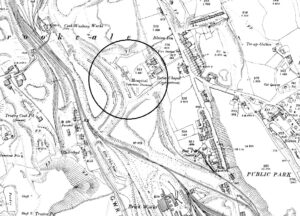 The Isolation Hospital Contractor.
The Isolation Hospital Contractor.
On Thursday 23rd of June 1892, a meeting of the Nantyglo and Blaina Local Board was held at the board offices, Blaina. Those present were as follows – Mr John Dakers (Chairman); Mr Thomas Morgan; Mr J. P. D. Williams; Mr George Bennett; Mr W. Parry (Contractor); Mr Edwin Griffiths; Mr William Rees; Mr Edmund Harris; Mr W. Parry (Grocer); J. A. Shepard (Clerk); Mr H. C. Bevan (Medical Officer); Mr George Stevens (Surveyor); Mr John Collins (Inspector of Nuisances) and Mr R. Williams (Collector): At this meeting the tender of Mr Charles Bunning of Pontypool was accepted for the construction of the isolation hospital on the edge of the grounds of the Berea Chapel (as seen circled on the map right), below the Blaina Inn, at an estimated cost of £428. 0s. 0d. his was one of 12 tenders that had been received. The tender did not include the supply of beds, bedding, fitments or the preparation of the ground, which was estimated to cost over £100.
It was reported that a large batch of bills had been presented to the local board in connection with expenses with the epidemics amounting to £171 and expenses were still being incurred. At this point the Brynmawr Local Board wrote to the Nantyglo and Blaina Local Board asking to amalgamate and erect a joint isolation hospital, though Mr J. P. D. Williams replied they would rather work separately as any co-ordination would disrupt the tender’s procedures that had already been put in place.
In July 1892 it was announced that the small-pox epidemic had diminished with no new cases reported. There was a case of typhoid fever at 170 High Street, there were a few cases of scarlatina still in the area and the local board was urged by the Medical Officer Mr Bevan to complete the building of the isolation hospital as soon as possible as there was a fear of a cholera outbreak in the district. The houses leased by the local board at Inkerman Row used as a temporary isolation hospital were being kept as an isolation unit until the permanent hospital was built.
In August 1892 a portable disinfecting apparatus in the form of a vehicle was purchased at a cost of £95. The local board accepted the tender of Messrs J. Fraser & Co of London on the motion of Mr J. Dakers (Chairman) and Mr J. P. D. Williams.
In January 1893 the Nantyglo and Blaina Company were prepared to let the ground that the isolation hospital was to be constructed to the Nantyglo and Blaina Local Board for the sum of one and a half pence per yard, which would amount to £2. per year. The clerk was instructed to write to the company and arrange for a 99 year lease though the company let the land on a 25 year lease. A letter was read from the Blaina Cottage Company requesting to hand the houses (that was used as a temporary isolation hospital) over to the company when the permanent isolation hospital was finished.
On Thursday 25th of May 1893, a meeting of the Nantyglo and Blaina Local Board was held at the Board Offices, Blaina. Those present were as follows – Councillor T. Morgan (Chairman); Mr J. P. D. Williams (Vice-Chairman); Alderman G. R. Harris; Mr J. Dakers; Mr Evan Williams; Mr Samuel Howells; Mr Llewellyn Blunt; Mr R. Rosser; Mr George Bennett and officers of the board: Mr H. C. Bevan reported a death from Typhoid Fever at 19 Vaughan Square, Nantyglo. The contractor had stated he had nearly completed the erection of the isolation hospital.
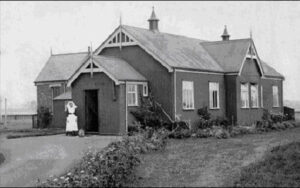 The Construction of the Isolation Hospital.
The Construction of the Isolation Hospital.
In July 1893 the Infectious Diseases Hospital at Blaina was completed for the sum of £480. The building was constructed of corrugated iron and match boarding with a layer of felt between. The whole of the building was resting on a brick foundation.
The hospital had 3 wards with an administrative building attached. A portable disinfector was also purchased at a final cost of £92. 10s. 0d. (The image above is of a typical design of an isolation hospital of the time. Nearly all of the corrugated iron and iron framed isolation units were built on this or a similar design).
The Caretakers.
In October 1893 Mr J. P. D. Williams announced that Mr G. Palmer and his wife were the caretakers at the Blaina Infectious Diseases Hospital, Mr and Mrs Palmer were from Colliers Row, Blaina and their terms of employment included free rent and fire and with payment to attend cases.
There was a case of typhoid fever at 16 Mount Pleasant, it was stated the cause may have been from a leaking drain that ran under the floor of the premises.
The Health of the Blaina District.
In March 1894 Dr H. C. Bevan presented to the Nantyglo and Blaina Local Board his annual report on the health of the district from March 1893 to March 1894. There were 550 births registered in the district, 271 males and 279 females born. There were 324 deaths recorded in the same period, 171 males and 153 females. The population of the district was 13,000.
There were many infectious diseases recorded which resulted in 100 deaths, including scarlatina, diphtheria and typhoid fever. Measles accounted for 49 deaths and was said that there may have been over 1000 cases in the district as many people didn’t report breakouts though the doctors were aware of many cases. Diarrhoea accounted for 22 deaths. Typhoid fever was reported and recorded at the following addresses – 5 Colliers Row, 6 Colliers Row, 2 Cross Street, 3 High Street, 15 Garn Road, 48 King Street, Solomons Tump, 15 Forge Row, 25 Twynderin, 14 Forge Row, 94 Abertillery Road, 4 Princess Street, 19 Pump Street, 2 Parrot Row, 4 Railway Terrace, 14 Parsons Row and number 87 Queen Street.
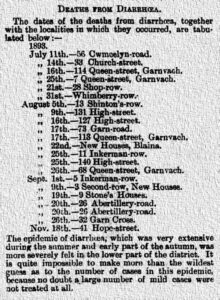 The cases of diarrhoea which resulted in the deaths of 22 deaths in the district during the year 1993-94 were (as seen left).
The cases of diarrhoea which resulted in the deaths of 22 deaths in the district during the year 1993-94 were (as seen left).
In May 1894 Dr Bevan the Medical Officer announced to the Nantyglo and Blaina Local Board that there had been two fatal cases of diphtheria at numbers 15 and 25 Part Street, New Houses, Blaina. One case of typhoid fever at 21 Griffiths Row, Nantyglo, the patient had survived but all bedding and beds etc had been disinfected. There were also 2 cases of typhoid fever at Caddicks Row, Blaina.
In June 1894 cases of diphtheria were being recorded in the district along with typhoid fever recorded at the following addresses – 4 and 5 Part Street, New Houses, Blaina and at 15 Stones Houses, Blaina. Scarlatina at 12 Church Street, Blaina and a fatal case of croup at number 170 High Street. Blaina.
In August 1894 there was an out-break of chicken pox, there was a case of scarlatina at number 12 Church Street, Blaina. It was isolated to the house and it was suggested to remove the patient to the isolation hospital though the parents refused to move the patient and promised to keep the child isolated at home. The medical officer was given complete authority by the local board over which cases had to be sent to the isolation hospital.
The local board reported that on the 24th of June 1894 after heavy rainfall, water had rushed down the mountain behind the Henwain Road and had chocked up the sewage on Abertillery Road, the result was filthy water accumulating in the gardens and back doors of the houses and shops etc. It was stated that this flooding occurred very often after heavy rain. The surveyor suggested to build a drain or large culvert at the backs of the premises to take away the sewage.
In November 1894 the Nantyglo and Blaina Local Board announced that there was a potential typhoid epidemic in the district with 6 cases being reported with 3 cases at No13 High Street, Blaina and one each at Round House, Nantyglo, Ffosmaen and King Street, Garnvach. It was stated that the isolation hospital was not being utilised as it should be owing to the lack of supplies and the refusal of some parents and guardians to have relatives and children removed to the hospital.
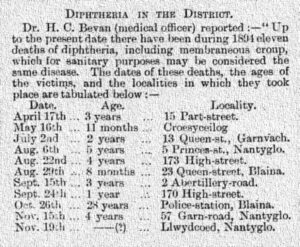 The Board Meeting to Discuss the Diphtheria Cases.
The Board Meeting to Discuss the Diphtheria Cases.
On Thursday 22nd of November 1894, a meeting of the Nantyglo and Blaina Local Board was held at the Board Offices, Blaina. The meeting included a “Special Report” on the spread of diphtheria in the area. Those present were as follows – Mr J. P. D. Williams (Chairman; Alderman G. R. Harris (Vice-Chairman); Mr Llewellyn Blunt; Mr E. Griffiths; Mr S. Howells; Mr W. Rees; Mr W. Parry; Mr R. Rosser; Mr E. Williams; Mr W. Gregson; Dr H. C. Bevan (Medical Officer); Mr R. L. Roach (Surveyor); Mr R. Williams (Collector) Mr J. Collins (Sanitary Inspector); Mr J. A. Shepard (Clerk) and Mr H. J. Baker (Deputy-Clerk): At this meeting the cases of diphtheria and other infectious diseases that were prevalent in the district was discussed. It was reported that 11 fatal cases of diphtheria had occurred in the past year which was recorded in the report (as seen on the list above).
The report stated the local board could not get the patients to the isolation hospital in time, as all but one patient had died within 48 hours of the onset of the disease and were too ill to be removed. There were non-fatal cases at 183 High Street, Blaina. A second case at 170 High Street, Blaina, the cases at the various addresses on High Street never had any connection with each other. The patient at the police station was P.C. No73 Thomas Lewis. It was said Mr Lewis had been away from Blaina for a period of nine days before the onset and must have contracted the disease from outside the area. The medical officers report stated that the whole police station 22 rooms had to be disinfected, all Mr Lewis’s possessions, bedding, bed, carpets and all his clothing was destroyed.
It was also stated that all contaminated bedding had been burnt at all the infected houses at a temperature of over 240 degrees, though the clothing at number 23 Queen Street, Blaina was disinfected by prolonged boiling in soda and it was also used to disinfect the house and drains etc.
In 1895 typhoid broke out along with a lot of other diseases. Brynmawr at this time had not yet established a hospital, there was a case where 25 lodgers quarantined in 2 houses and the council had to feed them for weeks.
December 1895 the Nantyglo and Blaina Local Board announced that typhoid fever had spread in the district, there were 8 more cases recorded at the following addresses – 22 Waun Ebbw, 12 Vaughan Square, 74 King Street, 5 Globe Pit Row, 261 Abertillery Road (back of), numbers 8 and 81 Queen Street, Blaina and number 16 Quarry Row, with 3 deaths from the disease being recorded. There were also 12 cases of scarlatina reported throughout the district during the month. On Friday the 27th of December 1895 the local board confirmed that there had been more cases of diphtheria and 10 cases of typhoid fever recorded at the following addresses – 27 Waun Ebbw, 34 Winchestown, 19 and 26 Chapel Road, Nantyglo, 57 Market Road, 62 King Street, 9 Queen Street, Blaina, 39 Hope Street, 7 Inkerman Row and 42 Abertillery Road. It was also stated that measles had increased in the lower part of the district and was steadily spreading to the Garn with over 200 cases being reported.
On Thursday 27th of January 1898, a meeting of the Nantyglo and Blaina District Council was held at the Offices, Blaina. Those present were as follows – Mr Llewellyn Blunt (Chairman); Mr J. P. D. Williams (Vice-Chairman); Mr J. Price; Mr J. Dakers; Mr T. Treharne; Mr D. Rees; Mr D. Lewis; Mr W. Roberts; Mr S. J. Howells; Mr W. Gregson; Mr W. M. Williams; Alderman G. R. Harris; Mr J. A. Shepard (Clerk) and Mr W. L. Roach (Surveyor): At this meeting the council announced that during 1897 twenty-three cases of typhoid fever had been recorded at the following addresses – 19 Mount Pleasant, 50 and 51 Market Road, 24 Chapel Road, Coalbrookvale, 73 Abertillery Road (two cases), 73 Abertillery Road, 21 Limestone Road (four cases), 14 Queen Street, Blaina, 21 Clock Row, 19 Church Street, Blaina, 28 Queen Street,Blaina, 1 Shintons Road (this patient was employed as a nurse at the isolation hospital). 17 North Blaina Cottages, 13 Cwmcelyn Road, and 22 Pump Road, Blaina, 30 Abertillery Road, 31 Railway Terrace and 50 King Street, Blaina.
In June 1898 three typhoid fever cases were reported at Garden House and another case at No58 Waun Ebbw, Nantyglo with a case of scarlatina at No7 Mill Street, Blaina. The council stated it had intended on moving the patients to the isolation hospital though they had great difficulty in employing a nurse, so they had no option but to keep the cases quarantined at their own homes.
In September 1898 four cases of typhoid fever was admitted to the Blaina Isolation Hospital. Three of those cases were recorded at the following addresses – 22 Vaughan Square and another from 4 Vaughan Square. Another case appeared at the latter address and also more cases appeared at 23 Twynderin, 33 Market Road, 14 Forge Rise, Nantyglo and 2 cases at Drew’s Houses, Blaina. Mr Davies (Inspector of Nuisances) stated the threat of the typhoid epidemic was great at this time. Cleansing and disinfecting of premises and the district in general was properly observed. No-one was to enter the isolation hospital and Mr Dakers considered posting “Rules and Regulations” on the matter upon the wall outside the institute.
In November 1898 more cases were being reported at Waun Ebbw, 6 Inkerman Row, 20 Club Row and at 81 Abertillery Road. The Nantyglo and Blaina District Council warned of the dangers of obtaining drinking water from Lester’s Spout. This spout was condemned in 1895 and since that date the whole of Coalbrookvale and the Trostre had been dependent on just two taps of pure water, one at Bristol House and the other at the Isolation Hospital, Blaina.
In June 1899 a report to the council showed four deaths from typhoid fever and one from diphtheria. More cases of typhiod had been recorded at 4 Palmers Row, 12 Shop Row, 1 Victoria Street and 26 Abertillery Road. Fresh cases of diphtheria had been reported at 171 and 19 High Street, Blaina, Pit Cottages, Turkey Town and five cases at a house in Bumbalow. The inspector said the premises at Bumbalow was in such a bad state with no drainage he advised that they should be properly drained or pulled down.
In August 1899 seventeen cases of diphtheria had been recorded in one month and an epidemic of measles had broken out with over 200 cases being reported and was rapidly increasing. The addresses were practically all the same as where the other breakouts that had occurred in previous years, i.e., High Street, Queen Street, Parrot Row and Colliers Row etc.
In June 1900 there were five typhoid fever cases and 27 cases of diphtheria reported in Nantyglo with 11 cases of scarlatina and 22 cases of diphtheria being reported at Blaina. No deaths from diphtheria were recorded as the medical officer stated it was a milder form of the disease as of previous.
On Thursday 23rd August 1900 a meeting of the Nantyglo and Blaina District Council was held at the offices, Blaina. Those present were as follows – Mr John Price (Chairman); Mr D. Rees (Vice-Chairman); Mr W. Roberts; Mr W. M. Williams; Mr T. W. Allen; Mr W. Manning; Mr E. Griffiths; Mr W. Gregson; Mr J. A. Shepard (Clerk) and Mr W. L. Roach (Surveyor); Mr T. Davies (Inspector) and Mr L. W. Richards (Collector): At this meeting the annual Health Report of the district was read, it was stated the diseases were rampant with over 300 cases of diphtheria being recorded during the year, 200 cases of scarlatina and over 1,000 cases of measles had occurred in the past year. The surveyor reported that the new sewage system which had been under construction for the past few years would ease the epidemics and he was sure the disturbance of the old soiled ground was to blame for a lot of the disease.
In August 1901 Mr John and Mrs Abigail Jenkins of Blaina were appointed caretakers at the Isolation Hospital, Blaina.
In January 1902 at a meeting of the Nantyglo and Blaina District Council the annual Health Report of the district was read, it was stated there had been 133 cases of diphtheria had been recorded during the year with three deaths reported. There were 86 cases of typhoid fever with one death reported. The report stated that the month of December had seen its lowest recorded figures of infectious diseases for the past two years. The intensity of the diseases at Nantyglo and Blaina was blamed partly on over-crowding with many houses being full to capacity and as many as 11 people living in one house. In one case an Italian Chip Shop worker lived in a two-roomed house at 72 High Street, Blaina with nine other people living there, one had contracted typhoid fever and was taken to the isolation hospital.
In regard to the overcrowding at Blaina and Nantyglo, the surveyor submitted an estimate for the erection of 55 houses under the Housing of the Working Classes Act, the statement showed that in order to cover the whole of the cost, including land purchase it would be necessary to borrow £12,000. The estimate was accepted and the council put forth plans to borrow the money and begin the building as soon as the land was obtained.
In 1903 there were on average 10 cases of diphtheria and 3 cases of typhoid fever occurring in the district. The cases of diphtheria fluctuated and ranged between 3 to 25 per month throughout the year.
In March 1906 the cases of infectious diseases and diminished greatly and the deaths attributed to these diseases were down to single figures. Though measles was still prevalent.
In 1903 the Blaina Isolation Hospital was reported as being unfit for habitation in the same year as the roof and windows were leaking with rain pouring in, the three wards and the caretaker’s rooms were unfit for habitation and the wooden flooring was rotting from lack of ventilation.
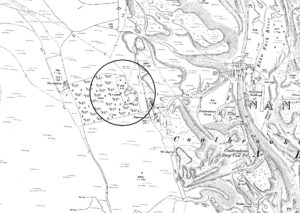 Ty-yr-Ywen Isolation Hospital.
Ty-yr-Ywen Isolation Hospital.
In October 1903 the Blaina Isolation Hospital closed as an isolation unit as it was deemed unfit for purpose and needed extensive repairs.
The Nantyglo and Blaina District Council purchased the large house Ty-yr-Ywen at auction for £380 during the sale of the properties of the Coalbrookvale Estate. The council bought the house with the intention of using it as an isolation hospital in the event that the permanent purpose built Blaina Infectious Diseases Hospital was beyond repair.
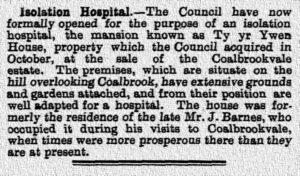 The Opening of the Ty-yr-Ywen House.
The Opening of the Ty-yr-Ywen House.
In July 1904 the Blaina Council formally opened the mansion known as Ty-yr-Ywen House in Coalbrookvale for the purpose of an isolation hospital. The old Isolation Hospital at Blaina was deemed beyond repair. The Ty-yr-Ywen House was formerly the residence of the late Mr J Barnes the Coal Master, Coalbrookvale Collery. The property comprised the house surrounded by 27 acres of land was situated on the side of the mountain not far from the old isolation hospital. It was in a state of disrepair and uninhabitable state and would cost the council a great deal in converting it into an isolation hospital with block wards. At the time it was purchased it was in the charge of man and wife, both caretakers.
On Thursday 23rd of October 1913, a meeting of the Nantyglo and Blaina District Council was held at the offices, Blaina. Those present were as follows – Mr Athron (Vice-Chairman); Rev G. Griffiths; Mr J. Manning; Mr W. Parry; Mr E. Beynon; Mr J. H. Jones; Mr J. Francis; Mr J. Pitman; Mr W. A. Jones; Mr T. LloydMr H. J. C. Shepard (Clerk); Dr J. L. Thomas (Medical Officer); Mr J. W. Davies (Surveyor); Mr L. W. Richards (Collector) and Mr W. T. Angell (Sanitary Inspector): At this meeting the medical officer announced that there had been 91 cases of scarlatina reported in the district 71 cases in Blaina, 10 in Nantyglo and 10 in Coalbrookvale. Dr Thomas said he had tried to stop the children who were suffering from the disease from going out to play in the streets of Blaina and he had attempted to obtain the names of the children’s parents for them to be prosecuted, though as no-one wanted to be implicated he told the committee as soon as he enters the streets they become empty and he cannot get any names. The council decided to send circular to the Sunday Schools asking then to get involved and to co-operate in preventing the spread of scarlatina in the district.
In July 1914 the Nantyglo and Blaina District Council recommended that the salary of the matron at the Isolation Hospital at Coalbrookvale, should be increased from £10. to £15. per annum.
The Closure of Ty-yr-Ywen Hospital.
The Nantyglo Isolation Hospital closed in the summer of 1914.
In June 1916 the Nantyglo and Blaina District Council were considering another site upon which to build another isolation hospital though was urged against it by some councillors who recommended the council to negotiate with the neighbouring Ebbw Vale and Brynmawr Councils to erect a joint hospital.
In May 1924, regarding the Nantyglo Isolation Hospital at Ty-yr-Ywen House, the report stated it had been unused over the past several years because of structural conditions, and in this year, subsidence occurred to render the hospital unfit for habitation. The patients had to be sent to Llanfoist Hospital, Abergavenny. The council were in a state of stalemate with the position of the hospital, it seems that they were paying £50 per year for the caretakers to stay at the hospital, it was stated that the ministry would not allow the sale of it, yet it was too costly to be put in a habitable state to receive patients. The building had suffered from subsidence, the council had had an offer of £500 but as stated, the ministry would not allow the building to be sold. Councillors agreed to approach the ministry and to ask them to allow the sale to go ahead.
In August 1924 the Ebbw Vale, Brynmawr, Abertillery and Nantyglo and Blaina District Councils arranged a meeting in connection with constructing a joint isolation hospital in the district.
The Payment for Treatment at Llanfoist Hospital.
In September 1924 another outbreak of scarlet fever occurred in Blaina and Nantyglo, the patients were treated at Llanfoist Hospital. Later the hospital at Llanfoist sent the Nantyglo and Blaina District Council a bill for £708. 14s. 1d. for the treatment of the 18 patients for the period from September to December 1924.
In the same year Brynmawr, Ebbw Vale, Nantyglo and Blaina set up a committee to propose the building of a joint infectious diseases hospital and invited the Abertillery Council representative to attend the meetings to see if they wanted to join in on the venture.
In January 1925 at a joint conference of representatives of the Ebbw Vale, Brynmawr, Abertillery and Nantyglo and Blaina District Councils it was decided on the proposition of Messrs Short and Aubrey to adopt the principle of joint Isolation Hospital accommodation in the district and to ask the Welsh Board of Health for permission to close Ty-yr-Ywen.
In April 1925 the Sanitary Committee of the Nantyglo and Blaina District Council received a bill for £354. 7s. 0d. for the treatment of the typhoid fever patients admitted from Blaina and Nantyglo, it was resolved to make a claim on the Bedwellty Board of Guardians for the amount due for them.
The Temporary Reopening of Ty-yr-Ywen Hospital.
On Monday 25th of May 1925, a meeting of the Nantyglo and Blaina District Urban Council was held at the Council Chamber, Blaina. Those present were as follows – Mr J. Chard (Chairman); Mr J. L. Adams; Mr L. Chaffey; Mr H. Ashton; Mr W. Hale; Mr C. Fear; Mr E. Lewis; Mr W. Davies; Mr W. T. Aubrey; Mr E. Cousins; Mr Evan Evans; Mr A. Sharrem; Mr S. Short; Mr L. A. Wallen (Clerk); Mr E. J. Helt (Assistant Clerk); Mr J. M. Job (Surveyor) and Mr W. T. Angell (Sanitary Inspector): At this meeting a case of typhoid fever at 11 King Street, Nantyglo was discussed, the patient had to be transferred to the Abertillery Isolation Hospital. The council was asked if it could possibly get a few rooms in the old Ty-yr-Ywen Isolation Hospital habitable in case of another outbreak.
The Welsh Medical Board was asked to give money for the temporary repairs though stated they would not visit to inspect the house but would take the word of the surveyor. The caretakers at Ty-yr-Ywen stated there had been no subsidence for at least the past four years and they believed that it could be patched up sufficiently to accommodate a few cases if needed. It was said that the house as it was or if patched up would not be up to any standard to receive fever patients and it was resolved to again push for a sale as they could then move forward with another scheme.
In July 1925 another outbreak of typhoid fever hit the district. Dr Bruce-Lowe of the Welsh Board of Health had inspected the hospital and gave the go ahead for the temporary repairs needed to house to deal with the cases. The Board of Health had also engaged Nurse Walters of 17 Limestone Road, Nantyglo to assist in nursing the cases. Later reports stated the patients had been removed to the council’s isolation hospital. They had been conveyed to the hospital on stretchers by the Blaina Ambulance Brigade. The sanitary inspector reinstated the services of Mrs Hutton as nurse at the isolation hospital.
November 1925 it was reported that the five typhoid fever patients at the Isolation Hospital, Nantyglo were slowly recovering and two were well enough to be sent home.
The Closure of Ty-yr-Ywen Hospital.
In December 1925 the last typhoid fever patient left the Isolation Hospital, Nantyglo. It was hoped that the district was then free of the disease. Dr Bruce-Lowe reported that the isolation hospital was unfit for other patients and the Nantyglo and Blaina Urban District Council made arrangements to send any future cases of infectious diseases be sent to an isolation hospital near Cardiff.
In July 1926 Ty-yr-Ywen was disused once again and leased out by the council to a family who were homeless. The Blaina Council were sending any future cases of infectious diseases to Newport.
The industrial unrest and financial situation in the country during the mid to late 1920’s overshadowed the talks between the various councils in connection with a joint isolation hospital and the scheme was postponed.
In December 1926 the Nantyglo and Blaina Urban District Council decided to sell Ty-yr-Ywen, the isolation hospital building. At this time the council were involved in a large housing project, they had arranged for homes to be built and they stated that they had 370 applicants for 20 houses. The council were also considering “afforestation” at Nantyglo and Blaina and were in talks with the Forestry Commission.
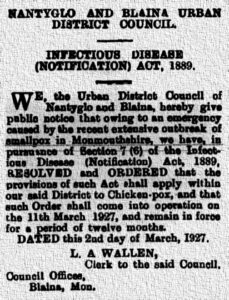 In March 1927 a small-pox epidemic swept Monmouthshire and 250 cases were reported throughout the county. Nantyglo and Blaina district was not badly affected with only 1 case being recorded (this was later refuted and the council issued a statement which read that there were no cases in the Nantyglo and Blaina district). It was stated the Abertillery and Abergavenny Isolation Hospitals were being used to treat patients at this time. The chief county medical officer said a few cases had a connection with Abersychan and that place was a hot bed for the infection and all football matches had been postponed.
In March 1927 a small-pox epidemic swept Monmouthshire and 250 cases were reported throughout the county. Nantyglo and Blaina district was not badly affected with only 1 case being recorded (this was later refuted and the council issued a statement which read that there were no cases in the Nantyglo and Blaina district). It was stated the Abertillery and Abergavenny Isolation Hospitals were being used to treat patients at this time. The chief county medical officer said a few cases had a connection with Abersychan and that place was a hot bed for the infection and all football matches had been postponed.
Cases of chicken pox had also risen in the district and the medical officer also put forth plans for a mass vaccination programme in the schools within the area. Notices were also erected to warn of the dangers of the infectious diseases and that sufferers of smallpox were not to enter public vehicles, public buildings such as schools, cinemas or lodging houses.
The Sale of Ty-yr-Ywen House.
In May 1927 Auctioneers, Messrs Tong and Cobon F.I.A. sold at auction the freehold residence and former Isolation Hospital Ty-yr-Ywen House. The property consisted of a garden, garage and grounds containing an area of over one acre, with pastureland and plantation adjoining with an area of over two acres. The building consisted of first floor- Six bedrooms, boxroom and bath & w.c. Ground floor – Six rooms, kitchen, two large pantries, a cellar, coal house and w.c. It was sold for £340 on a reserve of £200. The buyer was Mr George Coleman, the tenant of the house at the time of the sale.
On Monday 30th January 1933 a monthly meeting of the Nantyglo and Blaina District Urban Council was held at the Council Chamber, Blaina. Those present were as follows – Mr A. Sharrem (Chairman); Mr W. Lloyd; Mr D. Williams; Mr E. Silk M.A. L.L.B; Mr W. Madden; Mr W. W. Hale; Mr J. L. Adams; Mr C. Fear; Mr J. Jones; Mr J. Chard; Mr E. Lewis; Mr T. Jones; Mr E. J. Helt (Deputy Clerk) and Mr J. E. M. Job (Sanitary Inspector): It was noted that Mr L. A. Wallen the Clerk and Mr W. Beynon the Rating Officer were both down with the flu. At this meeting it was reported that the County Medical Officer had suggested and put forth a paper on the provision of isolation hospitals, it suggested closing all small hospital units and having one large isolation hospital. Abertillery would have been grouped with Abercarn, Ebbw Vale, Risca, Nantyglo and Blaina and served by a new hospital at Crumlin. The discussion was referred pending a full report.
It was also suggested that it be taken from the district council and put into the hands of the county council.
In the late 1930’s spotted fever (Cerebro-Spinal Meningitis) broke out in the valley between Brynmawr and Abertillery, some of the patients were taken to an Isolation Hospital at Bargoed. As time passed, the services, facilities along with health and hygiene in the district improved and the infectious diseases cases became very few and far between. The need for specialist isolation hospitals diminished.
Points of Interest – The information that follows was a typical monthly report issued by the Medical Officer of the Nantyglo and Blaina Local Board – In May 1893 Mr H. C. Bevan the Medical Officer for the Nantyglo and Blaina Local Board announced that there had been 38 births in the district in the one month. There were 18 males and 20 females born. The consumption of water for the same period was as follows – Domestic usage was 3,353,000 gallons and for industrial use 1,377,000 gallons used.
In June 1893 the medical officer announced there had been 45 births in the district in that month. There had been 25 males and 20 females born. There were 15 deaths in the same period.
Ty-yr-Ywen.
The Ty-yr-Ywen the House at Coalbrookvale was spelt in various ways on many reports and different maps. Mostly known as Ty-yr-Ywen but also as Tyr Ewen, Ty-yr-Wen and Ty Ewen.
 Out Of The Blue Artifacts A Library of a lifetime of collecting
Out Of The Blue Artifacts A Library of a lifetime of collecting
